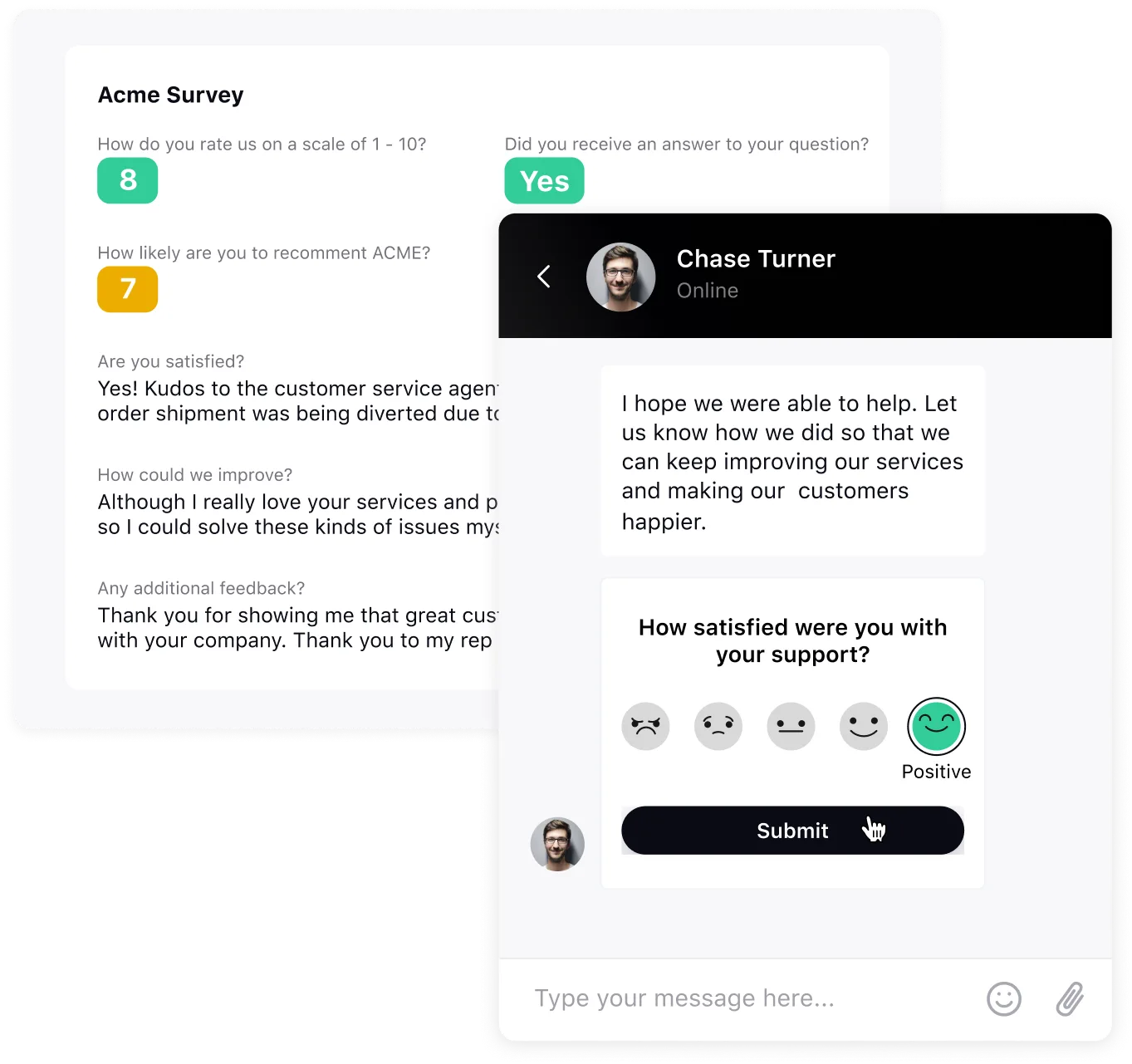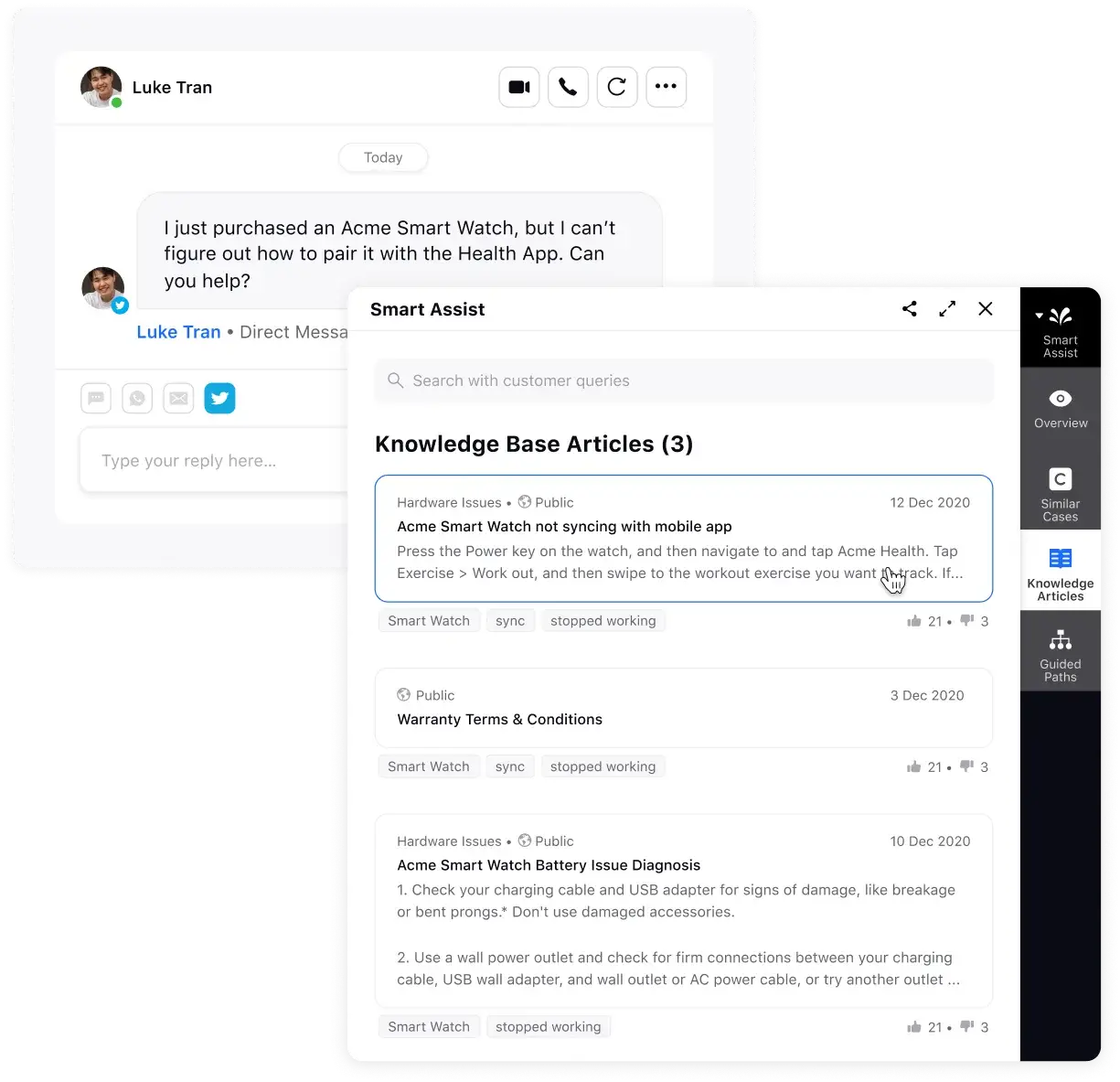- What is customer service?
- How does customer service work?
- Customer service vs. Customer experience vs. Customer support
- Five pillars of customer service
- Top benefits of customer service for all sectors
- Evolution of customer service
- Seven types of customer service channels
- How to deliver good customer service using tools
What is customer service?
Customer service is the support you provide to customers through voice, chat, SMS, email and social channels. It plays a pivotal role in the customer journey, spanning pre-purchase to post-purchase stages, significantly influencing customer satisfaction and retention rates.
Customer service is “good” when you promptly answer customer queries about your offerings, assist customers through payment issues or technical glitches and guide them before and after purchase.
Customer service becomes “memorable” when you anticipate issues proactively and reach out to customers before something happens, ensuring customer satisfaction and loyalty.
On this page, we discuss why customer service has become the building block of business core strategy today and what you can do to differentiate customer service in 2024.
How does customer service work?
Customer service works in three different ways:
Reactive support
The most traditional mechanism of customer service delivery is reactive, and it usually starts when a customer reaches out to a business seeking information or support.Customers contact customer service through a preferred channel (phone, email, app).
The problem is identified by active listening and asking questions.
The issue is resolved instantly, or a follow-up is scheduled.
Post resolution, feedback is solicited to gauge customer satisfaction and identify areas of improvement.
With this approach, the business’s call or contact volume tends to increase, compounding overheads and delaying resolutions, which can lead to customer frustration and even churn.
Proactive support
The problems with reactive support led to the emergence of proactive customer support, where businesses anticipate customer issues before they become tickets and establish systems/processes to deliver instant resolutions by:Social listening: Listen to relevant customer conversations, pick negative sentiments and swoop in with recommendations and resolutions. This approach resolves immediate concerns and contributes to building a customer-centric brand reputation.
Customer self-service: Identify top contact drivers by analyzing contact trends and customer feedback and then build self-serve resources (like tutorials, knowledge base, FAQ chatbots etc.) to enable customers to self-seek resolutions without calling customer support. With proactive support empowering customers to solve their issues autonomously, the contact volume gradually decreases, and customer satisfaction increases, making it a win-win for businesses and customers alike.
Predictive support
AI-led predictive intelligence uses customer data to predict future customer behaviors (like churn or purchase) in every scenario. It can then recommend the next best actions intelligently to support sales and marketing teams working collaboratively to achieve desired outcomes.
Let’s understand with an example: A customer who just completed a purchase with your business is likely to scout for complementary products, which presents a cross-selling opportunity for your marketing teams. The customer might be looking for product usage information, so your customer support or customer success team should step in. Timely intervention encourages positive customer behavior and improves customer retention.
Interesting Read: How Different Is Customer Success from Customer Experience?
Customer service vs. Customer experience vs. Customer support
Though some may think of customer service, customer experience, and customer support as similar, this is not the case; they have their differences, as expressed in the table below.
Aspect | Customer Service | Customer Experience | Customer Support |
Definition | Provides assistance and support | Encompasses all interactions to shape perception | Addresses and resolves specific customer issues |
Focus | Reactive. Caters to customer needs | Proactive. Shapes customer perceptions | Reactive. Resolves customer inquiries |
Scope | Transactional, issue-focused | Holistic, covers the entire customer journey | Transactional, focused on specific problems |
Timeframe | Immediate, short-term impact | Long-term impact, ongoing relationship building | Immediate, short-term issue resolution |
Interaction | Company or customer-initiated interactions | Customer-centric, considers customer viewpoint | Company-initiated, resolves customer inquiries |
Impact | Immediate resolution of issues | Long-lasting impression, loyalty and advocacy | Immediate resolution of customer inquiries |
Further reading:
Five pillars of customer service
You serve customers better when you understand the key pillars and foundational blocks of customer service. Here they are:
Communication channels
Communication channels form the cornerstone of robust customer service, serving as the primary pillar for delivering exceptional customer experience and support. They ensure accessibility and convenience by catering to diverse customer preferences through various channels like phone, SMS, email, live chat and social media.Customer satisfaction
Like proactive support, maintaining a consistent level of customer satisfaction hinges on factors like responsiveness, service speed and swift issue resolution. It's essential to cultivate a sense of accountability among your agents, making them understand that the foundation of customer success begins at their workstations.Did you know: Today, you can quickly build a CSAT survey, deploy it across all your customer service channels and then see the results in a single, unified report.
Check out how our omnichannel customer satisfaction platform does all of this:
Rich knowledge base
The purpose of a knowledge base extends beyond mere support. Consider the knowledge base as a content repository designed to educate, motivate and assist customers in resolving their issues when necessary. It can act as a single source of accurate information. You can set up a team for monthly reviews who can remove outdated content and update the knowledge base regularly.Training and coaching
Agent training and coaching empower your customer service representatives to excel and provide top-notch assistance. Through continuous customer service training, agents are equipped with the knowledge and abilities to address diverse customer needs effectively. This includes mastering your company's products or services, honing communication skills and developing strong problem-solving capabilities. And all of it requires customer service coaching.
Read more: Learn How to Coach Your Customer Service TeamCustomer service metrics
Customer service metrics offer a clear and objective way to evaluate the performance of your service teams and individual agents. It is usually categorized into four types:-Quality metrics
Performance metrics
Efficiency metrics
Employee satisfaction metrics
It also aligns your customer service efforts with broader business objectives, ensuring that your customer service strategy supports revenue growth and customer retention goals.
Moreover, customer-centric metrics like Net Promoter Score (NPS) and Customer Effort Score (CES) keep your focus on the customer experience, helping you tailor your service to meet and exceed customer expectations.
Dig Deeper: Customer Service Pillars – Explained in Detail
Top benefits of customer service for all sectors
Attention to customer service can help you build a positive brand perception and boost your long-term customer success initiatives. Here are the other key benefits.
Improved customer satisfaction
Superior customer service is synonymous with shorter hold times and quicker resolution times. Prioritizing customer service and offering timely support can lead to an increased customer satisfaction rate and higher retention rate.💡 Pro Tip: Customer satisfaction drops when customers don’t receive the resolutions they seek at the first point of contact. That’s why you need to focus on resolving queries in the first attempt itself (first contact resolution or FCR) by following these five steps: -
Benchmark your FCR
Build a knowledge base
Train your agents
Instil a proactive approach
Minimize circle time
Read this article on First Contact Resolution to understand how to execute these five steps!
Greater competitive advantage
In today's competitive market, outstanding customer service sets you apart. Businesses with a reputation for excellent service are often chosen over alternatives, attracting more customers.Increased customer loyalty
Exceptional customer service lets you create a solid emotional connection with your customers. When customers feel valued and well-supported, they are more likely to remain loyal to your brand and continue using your products or services.Positive word-of-mouth and referrals
Satisfied customers are likely to share their positive experiences with friends, family and online communities. This positive word-of-mouth, often driven by high Net Promoter Scores, can significantly enhance your brand's reputation and bring in new customers through referrals. Happy customers, acting as your advocates, expand your reach and attract new customers who trust genuine recommendations.
Interesting Article: Happy Customers Buy MoreHigher customer lifetime value
Customers who experience superior service are more likely to make repeat purchases and spend more over their lifetime. This increased customer lifetime value contributes to your long-term revenue growth.
Evolution of customer service
Customer service has evolved significantly over the years to meet the changing needs and expectations of consumers. Initially, businesses focused on providing basic assistance and resolving complaints. However, as competition increased and customer expectations grew, the role of customer service expanded to include proactive support, personalized interactions and omnichannel engagement.
Basic assistance: Initially, customer service primarily involved addressing customer complaints and providing basic assistance.
Proactive support: Businesses began to anticipate customer needs and offer proactive support to prevent issues before they arise.
Personalized interactions: With the rise of data analytics, businesses started personalizing customer interactions based on customer preferences and behaviors.
Omnichannel engagement: The evolution of technology led to the adoption of omnichannel customer service, allowing customers to interact with businesses through multiple channels seamlessly.
Virtual and augmented reality: VR revolutionized training methods while enhancing customer experiences. It allows agents to immerse themselves in realistic scenarios, improving their skills and empathy. Furthermore, the penetration of generative AI in support is streamlining processes and providing personalized solutions.
Seven types of customer service channels
Communication channels are one of the major pillars of customer service. Your customer will reach out to you for help through one of these seven channels or using all of them simultaneously.
📢Voice
Customers connect with businesses through toll-free numbers, entering queues to await assistance. Although effective, long waiting times can frustrate customers. Businesses leverage Interactive Voice Response (IVR) systems, reducing call volumes, average hold times and operational expenses.
📱SMS
Mobile messaging or SMS communication has gained traction due to its convenience. Customers easily submit service requests by sending a few words to a designated number. While SMS doesn't directly provide solutions, it helps customers bypass the process of raising tickets or enduring service call queues. Companies arrange callbacks, enabling customers to access assistance at their convenience.
Be a Pro: Customer Service Messaging - Everything You Need to Know in 2024
📧Email
Many customers favor emails as they allow them to explain the issues in detail and at their own pace. Threaded conversations offer comprehensive timelines, including concise documentation for future reference.
👥Live chat
Real-time text-based interactions on live chat support offer a balance between speed and personalized support. It's popular for its convenience, quick responses and readily available chat logs. Automated chatbots promptly address common queries, enabling agents to focus on complex conversations. Industries like banking, eCommerce and travel heavily rely on live chat for customer service.
🔧Self-service
Customer self-service empowers customers to find solutions 24/7 through FAQs, knowledge bases and tutorials. Particularly effective for straight queries, self-service reduces queue congestion, accelerates time-to-resolution and enables customer service teams to focus on more intricate issues.
👤Virtual agents
A virtual agent offers frontline assistance, swiftly addressing all your customers' service requirements. Going beyond the capabilities of chatbots, virtual agents use natural language processing to interpret human inputs and understand their intent.
📲Social Media
Customers engage publicly on social media platforms. Raising service requests via direct messages (DM) offers ease compared to traditional help desks or customer service lines. Prompt responses and callbacks demonstrate your commitment to customer satisfaction, showcasing your brand as socially aware and proactive.
Beware: While you juggle through these seven channels, you might miss out on an important conversation. Common wisdom says you do 99 things right, but doing one wrong will still be counted as a mistake. To avoid that one mistake, deploy omnichannel CCaaS to keep all communication channels under one roof.
How to deliver good customer service using tools
Emmert Wolf once said a man is only as good as his tools. If you need to ensure you are prepared to give the best customer service, you need to look at the kind of tools you possess. Modern problems need modern solutions. We are sharing different customer service tools that can come in handy during different example scenarios, improving your brand's overall customer experience.
Essential customer service tools for technology companies
The tech industry needs explainer video tutorials and FAQ chatbots because tech buyers often encounter issues and appreciate troubleshooting content and instant answers.
Example scenario: A new iPhone user is finding it hard to use iMessage, which is why they can’t receive OTPs or important information.
Tools needed: A knowledge base article or video on using iMessage
Solution: Either share troubleshooting content (like the one in the screenshot below) over email or direct the customer to it via your contact center agents or chatbots, whatever the customer uses to connect with you.
Essential customer service tools for travel companies
The travel industry needs advanced customer service tools due to changing customer needs. They need instant support and constant guidance across multiple channels. Tools like omnichannel support and social media customer service can greatly improve customer satisfaction since many travel searches start on social media.
Example scenario: A new-gen travel agency wants to provide customized travel packages for their users and guide them through the whole itinerary during the journey
Tools needed: Omnichannel support and social customer care
Solution: A traveling customer would be happy if they get omnichannel support on email, WhatsApp and website so that their travel information is preserved and transferred to whatever channel they use during travel. Likewise, social customer care will enable them to share notes, reviews and pictures on one platform.Essential customer service tools for the energy sector
Customer service in the energy sector can be really challenging, attributing to the nature of the industry, regulatory environment and complexity of services. But with better tools, you can face the toughest challenges, just like DTE Energy did.
DTE Energy is one of the largest energy companies in the United States, serving 450 communities and some 2.3 million residential and business customers.
The challenge: Owing to high contact volumes and resulting agent burnout, DTE’s annual contact center attrition rate was over 40% and attracting new talent was becoming increasingly difficult. The existing customer service team struggled to meet its Service Level Agreement (SLA) and was ill-equipped.
The solution: DTE implemented Sprinklr Service to offer live chat as a support channel to its customers, giving the flexibility to handle multiple customers at the same time.They decided to experiment with live chat on two web pages: one for customers moving in or out and another for billing inquiries.
They started slowly, closely monitoring customer adoption and chat volume.
Two phone groups, from billing and move-in/move-out teams, were trained to handle chats for half of the day and phone calls for the other half.
Over time, the agent satisfaction score in DTE’s contact center climbed to 4-4.5 out of 5. The attrition rate dropped from 40% to 2.3% every month.
What's more?
The customer service team achieved a 38% reduction in case duration. An issue that previously took 12 minutes to resolve on a voice call was now handled in 4.5 minutes via chat.
Your takeaway: Time is invaluable in customer service. If a customer service tool can save a few precious minutes, imagine the impact it will have on your first contact resolution, CSAT and overall customer experience.
Schedule your Sprinklr Service demo and witness the results firsthand.
Frequently Asked Questions
Thank you for contacting us.
A Sprinklr representative will be in touch with you shortly.
Contact us today, and we'll create a customized proposal that addresses your unique business needs.
Request a Demo
Welcome Back,
No need to fill out any forms — you're all set.




